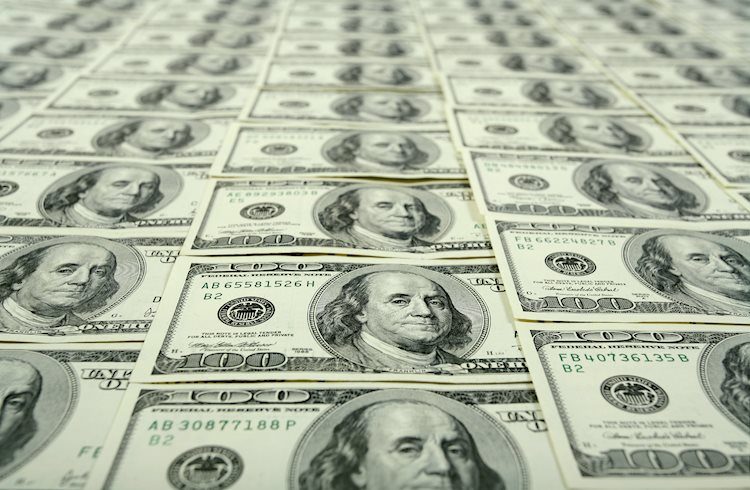
- The DXY rose by more than 0.50% to 104.50 on Monday.
- The US service sector continues to show robustness, making markets disregard an interest rate cut in March.
- US Treasury yields continue to rise, boosting the Greenback.
The US Dollar (USD) measured by the DXY index rose on Monday to 104.50, its highest level since mid-November. This upswing has been attributed to the fortifying ISM Services PMI for January, giving the Dollar Index an advantageous boost via markets giving up on hopes of an interest rate cut in March.
The US Federal Reserve’s hawkish hold, justified by a robust jobs report and continuous strong growth in Q1, is making any imminent rate cuts implausible, contradicting previous market expectations. Federal Reserve (Fed) Chair Powell maintains cautiousness, emphasizing the need to observe inflation’s sustained drop toward the 2% core target.
Daily digest market movers: US Dollar gains additional ground as Services PMI comes in higher than expected
- January’s ISM Services PMI recorded 53.4, beating the consensus figure of 52 and last month’s 50.5, as reported by the Institute for Supply Management (ISM).
- US bond yields continue to rise to monthly highs with 2-year, 5-year and 10-year bonds trading at rates of 4.45%, 4.11% and 4.15%, respectively. All three rates are up by more than 2%, which is making the US Dollar attractive for foreign investors.
- CME’s FedWatch Tool hints at lesser odds for a rate cut in March, currently standing at 15%. Those odds rise to 50% in May, but the probabilities of a hold are also high.
Technical analysis: DXY bulls extend gains and recover the 20-day SMA
The indicators on the daily chart reflect a potential shift in momentum in the short term. The Relative Strength Index (RSI) is nearing overbought conditions, which typically suggests that buyers may be losing their grip, although it does not immediately indicate a trend reversal.
However, evaluating the broader scale technical outlook paints a slightly different picture. The index now stands above the 20,100 and 200-day Simple Moving Averages (SMAs), suggesting a strong and sustained push from the bulls. This can be interpreted as a bullish signal on a broader outlook.
The overall combination of these indicators suggests that despite the RSI nearing overbought territory, the buying momentum, backed up by the rise in the Moving Average Convergence Divergence (MACD) and the position above the SMAs, is the more dominating force. Bulls look set to maintain control for now, especially as they continue recovering, which can often incite additional buying interest. That being said, traders should eye a potential reversal, due to indicators nearing overbought conditions.
US Dollar FAQs
The US Dollar (USD) is the official currency of the United States of America, and the ‘de facto’ currency of a significant number of other countries where it is found in circulation alongside local notes. It is the most heavily traded currency in the world, accounting for over 88% of all global foreign exchange turnover, or an average of $6.6 trillion in transactions per day, according to data from 2022.
Following the second world war, the USD took over from the British Pound as the world’s reserve currency. For most of its history, the US Dollar was backed by Gold, until the Bretton Woods Agreement in 1971 when the Gold Standard went away.
The most important single factor impacting on the value of the US Dollar is monetary policy, which is shaped by the Federal Reserve (Fed). The Fed has two mandates: to achieve price stability (control inflation) and foster full employment. Its primary tool to achieve these two goals is by adjusting interest rates.
When prices are rising too quickly and inflation is above the Fed’s 2% target, the Fed will raise rates, which helps the USD value. When inflation falls below 2% or the Unemployment Rate is too high, the Fed may lower interest rates, which weighs on the Greenback.
In extreme situations, the Federal Reserve can also print more Dollars and enact quantitative easing (QE). QE is the process by which the Fed substantially increases the flow of credit in a stuck financial system.
It is a non-standard policy measure used when credit has dried up because banks will not lend to each other (out of the fear of counterparty default). It is a last resort when simply lowering interest rates is unlikely to achieve the necessary result. It was the Fed’s weapon of choice to combat the credit crunch that occurred during the Great Financial Crisis in 2008. It involves the Fed printing more Dollars and using them to buy US government bonds predominantly from financial institutions. QE usually leads to a weaker US Dollar.
Quantitative tightening (QT) is the reverse process whereby the Federal Reserve stops buying bonds from financial institutions and does not reinvest the principal from the bonds it holds maturing in new purchases. It is usually positive for the US Dollar.